The Impacts of Wireless Communication on the Solar Industry Revolution
Radiocrafts has accumulated decades of experience in the solar industry by serving customers from all over the globe in solar tracking, inverter monitoring, energy storage projects, and more. Although we offer wireless radio solutions across various sectors within IoT, a discernible trend emerged some years back. An increasing number of clients approached us for solutions related to solar applications. Recognizing the significance of this trend, we decided to truly deepen our understanding of the solar industry.
Consequently, we decided to start taking an active part in revolutionizing the solar industry by participating in the Intersolar Europe and US, RE+, and other Solar related Exhibitions. These events provided us with invaluable opportunities to interact with existing clients and new prospects within the solar sector. Through our commitment to understanding the solar industry, much of the insights and information we will be presenting have been acquired through our efforts to delve deeper into this specific segment.
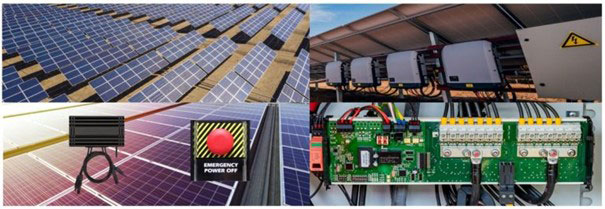 (Image source: Radiocrafts)
(Image source: Radiocrafts)
Therefore, in this blog, we will dive deep into the solar industry. We will begin by defining what the solar industry encompasses, exploring industry trends, examining the wide range of devices essential for powering solar installations, and expanding on the roles each device plays within the system. We will also compare cabling solutions against wireless alternatives, discuss wireless solutions tailored for the solar sector, and conclude by highlighting Radiocrafts’ RIIM mesh solution which supports several market-leading features optimized for the demands of the solar industry.
What is the Solar Industry?
The solar industry encompasses three distinct yet equally important segments:
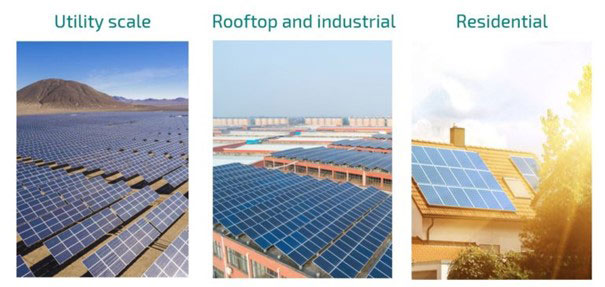 (Image source: Radiocrafts)
(Image source: Radiocrafts)
The first segment we will highlight is the vast and expansive utility-scale installations. These installations comprise of extensive arrays of solar panels, often numbering in the thousands. These solar panels are accompanied by solar trackers to ensure precise sun tracking for optimal angles throughout the day. Typically, these installations are situated in open fields and desert landscapes.
The second segment comprises medium-sized installations that are still substantial, yet not as expansive as those found in desert regions. These systems are commonly found atop rooftops and are categorized as the rooftop and industrial segment.
Lastly, we have the residential segment, which typically consists of single households or clusters of households equipped with solar panels on their rooftops. Some setups may also include energy storage and electric vehicle charging systems.
It is interesting to note that differences among these systems are influenced by grid codes, which dictate their interaction with the public electricity grid. Larger installations adhere to stricter requirements that define how they should feed energy into the grid and regulate output to prevent grid overload. Understanding these distinctions is crucial when comparing these diverse systems.
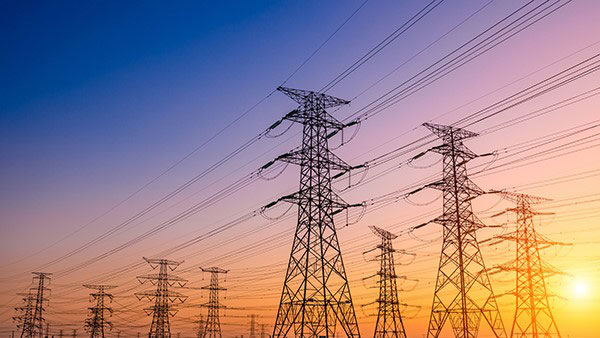 (Image source: Radiocrafts)
(Image source: Radiocrafts)
It is also worth mentioning that certain EU regulations now require the integration of solar installations in certain new building construction projects. This requirement is expected to significantly increase the number of installations, particularly in the rooftop and residential sectors.
What is the current Solar Industry trend?
Is there a discernible trend within the solar industry? Are we witnessing a shift towards residential and smaller installations, or is growth occurring across all segments mentioned?
Certainly, we can observe growth across all these segments.
Although there are slight variations in requirements and system configurations to meet radio specifications, overall, we observe a stable uptake across each of these segments.
What type of devices are in a Solar installation and what are their jobs in the system?
There are many devices that are commonly found in Solar installations with variations in component presence across segments.
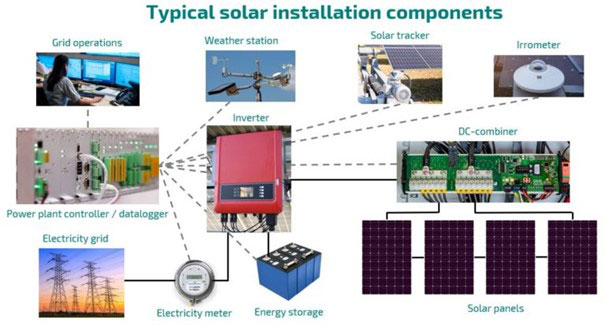 (Image source: Radiocrafts)
(Image source: Radiocrafts)
At the core of solar installations are the solar panels, often linked together in series, directing their DC voltage through a device known as a DC combiner. The DC combiner accumulates the DC voltage from the interconnected solar panels and boosts it to a higher level before feeding it into the inverter. In utility-scale installations, DC combiners play a crucial role in monitoring solar panels by detecting potential physical degradation over time.
In certain setups, solar panels may directly supply DC voltage to the inverter, allowing for architectural flexibility.
Subsequently, the inverter converts the DC voltage into AC main voltage, which is then transmitted to the electricity grid through an electricity meter.
Another vital component present in solar installations is the power plant controller or data logger. In large-scale installations with numerous inverters and DC combiners, this device is often referred to as a power plant controller. Its primary function is to transmit control commands to the inverters, enabling them to adjust their output in accordance with the requirements of the electricity grid.
In smaller installations, the device is mostly referred to as a data logger and is primarily focused on recording energy data produced by the inverter and detecting any malfunctions within it.
In large-scale installations, there typically exists a connection or an API linking the grid operator with the power plant controller. This enables the operator of the public utility grid to transmit commands to the power plant controller, allowing adjustments to be made to the output of the inverters in accordance with the grid's requirements. For instance, if an excess of electricity is being generated, the grid operator may instruct the power plant controller to reduce the output of the inverters. This communication typically has ultra-low latency requirements to ensure real-time adaptation of the inverters and to prevent potential grid overloads due to excessive electricity flow.
Various other devices are commonly found in large-scale installations, including weather stations, solar trackers for optimizing panel angles towards the sun, devices for monitoring the tracker angles to ensure the trackers are actually moving accordingly, and irrometers for measuring incoming sunlight intensity.
Energy storage also plays a significant role in solar installations with battery banks integrated across all installation sizes.
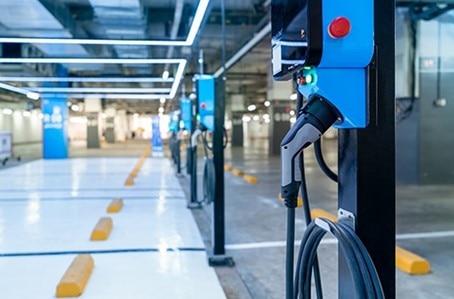 (Image source: Radiocrafts)
(Image source: Radiocrafts)
In residential and rooftop configurations, the adoption of EV charging stations enables support for electric vehicle charging. An integral component of residential setups is the energy manager which monitors consumption based on local energy production and grid energy pricing. It optimizes the operation of local loads to correspond with periods of lowest energy costs, such as when peak solar energy is being generated during the day.
In summary, a solar installation forms a sophisticated IoT system with extensive communication functionalities.
Cable versus Wireless Solution?
In today's large-scale installations, cabling solutions are the norm, involving intricate networks of fiber optic loops and kilometers of cables, including electrical, RS485, and fiber optic cables buried underground. However, wireless technology is gaining traction, offering numerous benefits for these setups.
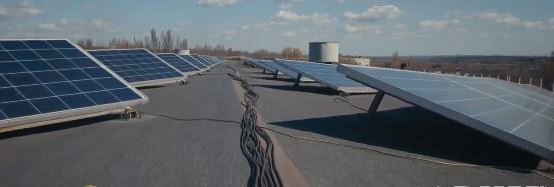 (Image source: Radiocrafts)
(Image source: Radiocrafts)
Wired connections pose challenges such as susceptibility to lightning strikes and ground loops, which can disrupt communication if a cable connecting multiple devices fails. Additionally, the cable replacement and repair process is labor-intensive and incurs substantial costs.
Recognizing these challenges, there is a growing interest in wireless solutions due to their significant cost savings and installation flexibility. While the conventional wired approach typically takes several days and substantial manpower to complete, the wireless alternatives offer quick and easy installation and adaptability. These advantages are what drive the increasing adoption of wireless solutions, particularly as demand rises for seamless and efficient system deployments.
Which wireless technologies are suitable for Solar installations?
There are numerous wireless technologies available, each tailored to the specific needs of the three distinct solar segments we discussed earlier, and the various devices needed to operate an efficient installation in each segment, resulting in diverse requirements.
One critical requirement is the need for long-range. Take, for instance, the residential segment where the system might include microinverters that are directly linked to a solar panel on the roof of the house. The controller would most likely be located inside the house which creates communication challenges due to the interference caused by concrete walls. Similarly, in non-residential rooftop installations, effective communication with rooftop inverters poses a range issue because the controllers are located several floors below in the building. In large-scale utility installations spanning kilometers, achieving long-range communication with every tracker and DC combiner is essential.
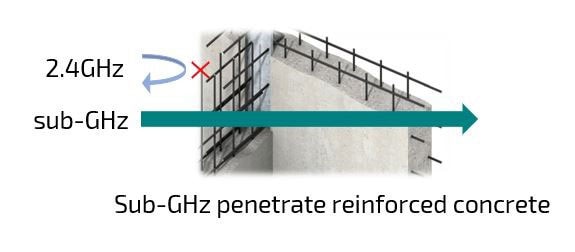 (Image source: Radiocrafts)
(Image source: Radiocrafts)
To address these range concerns, we see that Sub-GHz radio communication offers a superior solution compared to 2.4 GHz technologies due to the increased penetration properties and interference immunity supported by Sub-GHz technologies. Additionally, in scenarios where solar panels or inverters are spread across multiple rooftops within a single network, a multi-hop mesh solution is required to ensure scalability.
The combination of Sub-GHz and mesh technology proves highly effective for all three types of solar installations.
Another advantage of Sub-GHz mesh technology is shown in the following illustration. Here, a power plant controller communicates with a rooftop inverter, which then functions as a router, extending communication to and from other inverters. In this kind of solar setup, long-range is critical.
However, it's also important to note that latency requirements offer a contradictory consideration to range. When dealing with latency-sensitive equipment, careful attention to the communication equipment is essential.
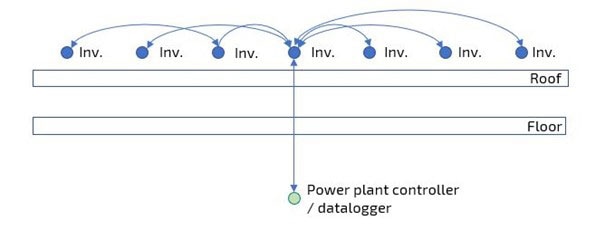 (Image source: Radiocrafts)
(Image source: Radiocrafts)
For example, when monitoring a weather station, there's no need to gather data every millisecond since weather conditions typically don't fluctuate that rapidly. However, situations requiring rapid adjustments, such as reducing voltage influx into the grid, require near real-time communication, especially when managing multiple inverters simultaneously.
Radiocrafts’ RIIM Mesh technology for Solar installations
Radiocrafts offers a long-range, low latency, Sub-GHz mesh solution, RIIM, which is highly suitable for all three solar installation segments mentioned above.
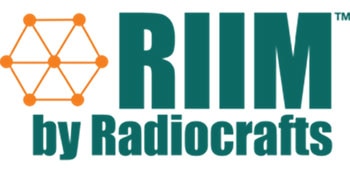 (Image source: Radiocrafts)
(Image source: Radiocrafts)
With RIIM, users have the flexibility to tailor various adaptations to suit different solar installation systems. For instance, some users may prioritize quick network joining times, while others may prioritize low latency or the ability to have numerous devices within a single network. These requirements can all be fine-tuned and prioritized within the network settings. Moreover, we offer extensive support for customer-specific development, meaning that if a customer desires additional features beyond the standard product offerings, we can support those requests.
In addition to the aforementioned range and latency concerns, reliability is also a crucial consideration. While cables are typically reliable, they are susceptible to wear and tear, which can lead to issues such as cable breakage and connector build-up. In contrast, wireless communication introduces the possibility of data packet loss. To mitigate this challenge, RIIM employs advanced technologies like "Time-Slotted Channel Hopping (TSCH)". TSCH is a protocol that enables data packets to be transmitted across different frequencies and time slots in a synchronized schedule. TSCH is world renowned as a frequency hopping system that works exceptionally well for getting 99.99% or higher data transmission reliability within a system.
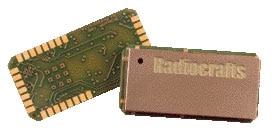 (Image source: Radiocrafts)
(Image source: Radiocrafts)
Data throughput is also a crucial consideration in a solar system design. The amount of data generated by each device varies significantly. For example, a weather station produces relatively little data, while a solar inverter can generate a substantial amount. System design decisions need to consider local processing capabilities at the inverter or solar panels, data filtering, and compression. Ultimately, the goal is to transfer a certain amount of data between devices efficiently. For example, if the network primarily transmits alarms, low latency is crucial but traffic volume remains low. However, if each device generates hundreds of bits of data per second, congestion may occur due to high traffic volume.
Addressing this latency issue is a key aspect of the RIIM network design, particularly for high throughput networking. In the EU, duty cycle limitations pose a challenge. For context, under the RED directive, you can only transmit data 1% of the time. This limitation significantly impacts high throughput systems. For example, using a LoRaWAN network, long-range data packet transmissions require a 10-minute wait between each packet to comply with the duty cycle rule. RIIM tackles this challenge by leveraging frequency hopping, allowing for the use of multiple radio channels to send data. Additionally, RIIM supports the Adaptive Frequency Agility feature to identify and exclude noisy channels from the frequency hopping list to ensure that the system is only using the most optimal radio channels to send data. Furthermore, RIIM utilizes Listen-Before-Talk (LBT) when sending data packets. The combination of these features is known as Polite Spectrum Access, which according to the RED Directive and EU standards, allows data transmissions for up to 37% of the time. This combination enables high throughput networking with minimal traffic congestion and packet loss.
 (Image source: Radiocrafts)
(Image source: Radiocrafts)
Furthermore, RIIM's robustness effectively manages noise interference from other protocols such as Sigfox or LoRa base stations, which operate within a single radio channel. If significant noise is detected in a particular channel, RIIM provides the flexibility to opt out of using that channel.
Additionally, the RIIM architecture is well-suited to scalable scenarios involving multiple parallel networks in utility-scale installations. For example, in a large-scale installation with potentially up to 10,000 solar panels, it is not feasible to connect them all to a single network. Instead, a solution where multiple networks operate in parallel, often in close proximity is necessary. If all these networks were to operate on the same radio channel, they would experience significant interference from each other. We have encountered instances where customers using single-channel systems faced significant interference issues when expanding their networks. However, RIIM's support for frequency hopping and unique synchronization methods ensures that networks automatically avoid interference. This inherent capability mitigates scalability concerns without requiring customer intervention.
What to take away from this?
The demand for renewable energies is surging as we attempt to fight the impacts of global warming. The solar industry is at the forefront of this quest for more sustainable power generation and living practices. From large-scale deployments comprising hundreds of thousands of solar panels and inverters in desert regions to individual households in our communities, every sector of society plays a vital role in advancing the solar movement.
Each segment of the solar industry relies on a diverse amount of equipment and devices to establish efficient solar installations. These devices include power plant controllers, inverters, energy meters, EV charging stations, energy storage systems, and more. Moreover, as the solar industry evolves, there's a gradual shift towards wireless solutions as a cost-effective alternative to wired solutions. Wired solutions often incur significant costs related to maintenance, installation, and labor.
A leading wireless solution tailored for the solar segment is Radiocrafts' Sub-GHz mesh technology, RIIM. RIIM offers a range of benefits, including long-range communication through its multi-hop mesh architecture, low latency, and ultra-high reliability achieved through channel hopping features. Furthermore, RIIM supports high data throughput, thanks to Adaptive Frequency Agility and Listen-Before-Talk features, making it well-suited for operation in noisy environments.

Have questions or comments? Continue the conversation on TechForum, DigiKey's online community and technical resource.
Visit TechForum










